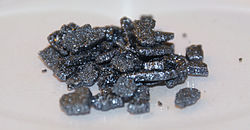Chemicals/Iodines
Appearance
Subject to atmospheric pressure and temperature, iodine can be gaseous, liquid, or solid.
Emissions
[edit | edit source]
Gases
[edit | edit source]
Solids
[edit | edit source]
The heaviest of the stable halogens, iodine exists as a semi-lustrous, non-metallic solid at standard conditions that melts to form a deep violet liquid at 114 °C (237 °F), and boils to a violet gas at 184 °C (363 °F).
